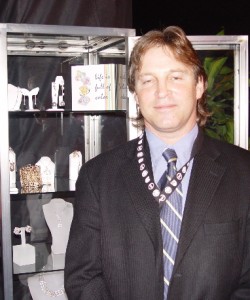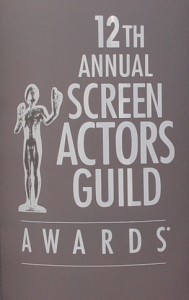
The past few months have been filled with award shows ranging from the American Music Awards to the Golden Globes. And if you have been paying attention to the media at all, it has become obvious that our celebrities are walking away with more than just trophies. We recently reviewed an award event that gave away 40,000.00 per gift bag per celebrity who attended. Well, the SAG Awards is no different. January 28, 2006, I visited the Shrine Auditorium backstage the day before the big event, and caught a glimpse of what our Hollywood royalty would be getting this time.
There were only a select few gifting for the 12th Annual Screen Actors Guild Awards®, but these goody bags carried a lot of weight. There were perfume, skincare, makeup, laser eye surgery gift cards, CD/DVD players, etc…. But the most exquisite and rarest present of all were fancy colored diamonds. I spoke with Alan Bronstein, the color diamond expert who is among the world’s most trusted advisors of colored diamonds to leading jewelers, fine jewelry designers, and private investors. He is the respected curator of the world’s most famous natural fancy colored diamond collections, the Aurora Collection and the Butterfly of Peace Collection. He lectures widely ranging from the United Nations to the New York University, and he has published two seminal books, Collecting and Classifying Colored Diamonds – An Illustrated Study of the Aurora Collection and Forever Brilliant: The Aurora Collection of Colored Diamonds. Alan explained just how rare and precious these gems really are.
Alan Bronstein has worked in the diamond business for 25 years as a diamond broker in the diamond business. Somebody came along with a yellow diamond, which was beyond his understanding. It changed the whole course of his career in terms of what he wanted to do with his life. He decided that he wanted to focus on these rarest of diamonds that existed in the world. He had never known that diamonds came in colors (most people don’t know). It became his mission to explain to people that diamonds do exist in different colors: yellow, pink, blue, orange, and green. Honored with such an experience, he wanted to let other people know that they existed, too. So, in the process of the last 25 years, he made a diamond collection, which has been in the Museum of Natural History in New York for the last 16 years. It is considered the finest diamond collection in the world. This has become Alan’s passion and his dream. He has become the advisor and spokesperson for the Natural Colored Diamond Association, an organization that wants to get the message out that diamonds come in different colors, that they’re made by nature, and that they can also be made by man.
 “We want to differentiate, and we want to let people know that there’s a difference between natural colored diamonds that come out of the earth (that were made by Mother Nature), and something that can be created in the lab by mankind, which you can make as many as possible and are not rare at all. I want to give you that same experience I had when I first saw the first colored diamond. I was so awestruck, and I wondered what I was looking at and how it came to be. It became my desire to learn as much as possible about fancy colored diamonds.”
“We want to differentiate, and we want to let people know that there’s a difference between natural colored diamonds that come out of the earth (that were made by Mother Nature), and something that can be created in the lab by mankind, which you can make as many as possible and are not rare at all. I want to give you that same experience I had when I first saw the first colored diamond. I was so awestruck, and I wondered what I was looking at and how it came to be. It became my desire to learn as much as possible about fancy colored diamonds.”
Alan was holding a necklace that had pink, blue and yellow diamonds. He put it in my hand and told me that this was the way they came out of the earth: they were cut by man, but created by God. When I looked at the diamonds for the first time, I was speechless. They were exquisite. I had no words to describe the beauty I was holding. It was literally breathtaking.
“The public does not know that diamonds exist in colors. For the most part, they know that diamonds are colorless objects. These are 99% of what exists in diamonds. One of the reasons that people don’t know that color diamonds exist is because they are so rare. They come in every color that nature has created flowers, seashells, and butterflies. That’s the beauty of nature. Nature has no limitations. There are 100 different brown, bronze, walnut and chocolate, cognac, and champagne colored diamonds. We brought to the SAG Awards for the presenters and award winners a bronze colored diamond in a necklace that we will be gifting the presenters and award winners.”
Fancy colored diamonds are so unique that most people will never get to experience them in their lifetime, unless of course, they see them in a jewelry store or museum. It’s not a terrible thing that people should have to spend a fortune on fancy colored diamonds, but to at least know that they exist in nature is Alan’s goal, to raise the consciousness of those who might not have known otherwise.
“I see it like a documentary. If somebody makes a film and takes me 2 miles down into the ocean and I see fish that I had never seen before, it would be my challenge to bring to the public something they might not have been able to experience.”
Even though these diamonds are pricey, Alan shows us the one silver lining in his collection. The chocolate or cognac colored diamonds which are in the orange and brown families, are actually affordable to the public. He wants to bring that to consumers’ attention so that they have options. When they go into jewelry stores, they might be able to buy something different than the white diamonds that they’re used to.
Fancy colored diamonds can cost a million dollars a karat for very rare green or red diamonds. They do not have to be very big either. It can be a 1-karat stone, which is not really that big, costing upwards of 1 million dollars. Alan emphasizes that the average person will not see these particular diamonds, but someone who knows what he/she is looking at will have the opportunity to see them. He wants to educate people so that they will know what they are looking at when they do see them.
“For every 10,000 colorless diamonds that exist, there might be one colored diamond. This is a number that has been around for the last twenty-five years. They are the most beautiful gemstones in the world. This is the trend that is taking place in the jewelry market. Fancy colored diamonds is the trend at the higher end, and we want to be able to show people that they are also available in modest prices from $1,000.00 to $5,000.00, which is affordable and in different colors. These lower priced diamonds can be just as beautiful also.
“People looking for fancy colored diamonds, can go into their local jeweler and ask for them. If that store doesn’t carry them, that jeweler should be able to make them available for their customer. I think in the coming years, you’re going to see a lot more of the fashion jewelry with fancy colored diamonds in all stores.
“Cartier, Harry Winston, Van Cleef and Arpels, Graf carry the more valuable stones. The champagne and cognac colors can be found at Zales, Bailey Banks and Biddle, Fortunoff, and the metropolitan areas. Most mom and pop stores, AGS (American Gem Society stores), do have something to show in fancy colored diamonds. Most people who walk into jewelry stores walk past them because they have no knowledge of what they are looking at. It’s very hard for people to ask questions about something if they don’t even know what it is they’re looking at.”
Alan feels that the jewelers need to start educating the customer that these gems do exist. Then you will see how the trend will take off with fancy colored diamonds.
I was curious about actually finding these diamonds in their raw form. I asked him in which areas in the world can these particular diamonds be found.
“Most blue and yellow diamonds are found in South Africa. Purple diamonds are found in Russia. Pink diamonds are predominantly found in Australia, as well as champagne, bronze, and cognac diamonds. Australia is the major source of fancy colored diamonds. Violet diamonds, which are extremely rare, are also found in Australia. Australia seems to be a place in the earth where there certain elements and formations of the ground. Thoses are where the rare colors in diamonds exist. So, Australia and South Africa are the major places where fancy colored diamonds are found.”
The collection of diamonds that Alan referred to basically sits in museums. It’s not set in jewelry, and has taken twenty-five years to assemble. It has been an ongoing project. It can be seen in the London Natural History Museum. This rare diamond collection tours the world, and goes to different museums.
“The Natural Color Diamond Association will be having an ‘over the top’ jewelry collection at the Oscars this year, and we should be dressing quite a few stars. We will be at the Mondrion Hotel.
“Some of the companies that specialize in setting these diamonds are Diatraco in New York; the company that has put together the bronze colored gift is called Mouawad out of New York. This is the company that created the 10,000.00 brassiere that Tyra Banks wore in her final Victoria Secret Runway show last year. It’s an example how diamonds do not have to be big, or valuable to be beautiful. We are very proud of this piece. We want to spread the message that, Brown, bronze and cognac diamonds are very chic too wear.”
Alan put the necklace set with a few brown diamonds in my hand. Even though the gems themselves were quite small, they really stood out as unique.
“Fancy colored diamonds are rare, beautiful, and chic. We want people to be aware that they exist.”
To learn more about fancy colored diamonds, visit: www.ncdia.com.
(Other gift items selected for the Talent Retreat included:
Amouge, Beverly Hills Physician.com, Coby Electronics, Lamarthe USA, LeVian Time®, Marchon Eyewear, PHYTO, Shu Uemura, and Starwood Hotels & Resorts French Polynesia.)
Interviewed and written by Kaylene Peoples